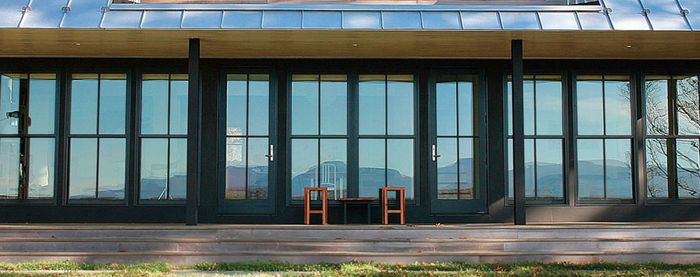How to Install a Prehung Exterior Door
Watch carpenter Andy Engel install an exterior door so it looks and works great.

Synopsis: Installing an exterior door so it works and looks great is an essential building skill. Carpenter Andy Engel is going to show us how to do it.
Video Transcript: I first wrap the bottom and sides of the opening with flexible flashing, and then check the rough sill for level. This sill was near perfect, but if it wasn’t, I’d shim it level.
After test-fitting the door, I apply three beads of window-and-door sealant to the bottom of the opening.
Next, I drive one 2-1/2-in. screw through the brick mold into the framing near the top hinge.
Then, I go inside to start shimming the door in the opening. Since the door bottom is sitting on a level sill, I only have to make the gap around the door consistent for the whole unit to be plumb. Here, at the top, the gap is wider at the latch side. Because the gap is wider on the latch side, I shim behind the bottom hinge. If the gap was wider on the hinge side, I’d shim behind the top hinge. Now that the gap is uniform around the door, I shim behind all the hinges for final fastening.
I remove one of the short screws in each hinge, and replace it with a 2-1/2-in. screw. These longer screws connect the jamb to the framing. Then I score the shims with a knife, and snap them off.
With the hinge side securely fastened, I close the door and adjust the latch-side gap, with shims above and below the latch. Then, I open the door and drive screws through the latch-side shims into the framing.
The final step is to drive 2-1/2-in. screws through the brick mold into the framing. I space them about every 12- to 14 in. all the way around the door.
And that’s how you hang a door.
_________________________________________________
Attention all tipsters!
We’re looking for any smart idea that would make a great There’s a Better Way Video or that could be featured in the Tips & Techniques department in Fine Homebuildingmagazine.
We pay for any tips that get published
You can post tips in our submit a tip blog, or just email them to Fine Homebuilding care of Chuck Miller. Thanks!
Plus, browse 30 years of great ideas in our Reader Tips department.


View Comments
This video while interesting is of no use to anyone who does not know how to hang such a door ,it should be called how to hang a door when everything is in the same plane ,the walls are plumb and the sill is level, this does not help anyone in the slightest trying to perform this skill , also screws every 12 in. In the brick moulding ,the painter must love that ,totally unnecessary
I don't quite understand the process. Quoting, "Next, I drive one 2-1/2-in. screw through the brick mold into the framing near the top hinge...
... If the gap was wider on the hinge side, I'd shim behind the top hinge."
Doesn't seem like it would do much good to shim behind the top hinge if the brickmold is screwed to the framing there. Worst case, I think it might twist the hinge side jamb.
I've never seen a door secured through the brickmold with screws. A few casing nails, yes, but screw heads would leave pretty big divots in the brickmold.
From the video, when you replace the standard short hinge screws w/ longer ones, it's important that you do the screws furthest from the pins- the near ones will often only grab sheathing end grain or even drywall.
Thanks for the comments. One great thing about screwing the brickmold in place is that the screws can be easily removed if it become necessary to adjust the hinges. As to the screw holes not pleasing the painter, well, I'm a carpenter. Pleasing the painter isn't my job. Sarcasm aside, it's not a big deal to fill a screw hole. Really. I've done it. Bondo is a great choice for this. And to my way of thinking, the superior holding that screws offer is worth their larger holes.
And yes, the long screws through the hinges always go in the inner holes of the leaf.
Finally, yes, it's true that this installation in a plumb and square opening showed the best case. That was deliberate. We could have shown what to do when that's not the case, but not in the short video we did here. We've covered those techniques in other videos (Mike Sloggat installing a patio door, for instance). One of the realities about content creation is that you always have to pick a stopping point - There's always more that could be said.
I have no beef with this video. Short and with no misinformation, it's a good intro.
One thing I like to do is check the rough opening for plumb as well, and if the hinge-side framing is perfect, I will screw the jamb directly to it, with no shims. It feels more positive to me, and it means fewer sets of shims. Further, I like to use an 18-guage "pinner" to keep shims in place over the long haul. I find screwing without a pilot hole can split shims.
I would also strongly advise checking how the door hits the stop before securing the latch side. If the framing on either side of R/O is not in exactly the same plane, you can end up with a door whose entire leading edge does not make contact with the stop, initially. Rather, it might contact high or low, before being persuaded to full contact. In this case, the door may not latch as positively as one might like.
"Massaging" the framing might address this issue, and/or you might have to cheat the (latch side) jamb's top or bottom corner toward the exterior. Of course, that could cause a ripple effect, and a painter bringing out the caulk, and brick mold that does not lie totally flush on the sheathing. But to me, the fit of the door is, shall we say, a higher calling.
British Columbia carpenter
Excellent information. If your door needs replacement because it was not protected by a sufficient overhang or it leaks due to a faulty prior installation, consider installing a DOORBRIM Door Canopy (doorbrim.com) above.
Good info but this isn't meant to help anyone that doesn't understand plumb, level or how the diagonal planes need to be considered. I don't agree with attaching the door using only screws through the brick moulding and a few hinges through the hinges. You need to go through the jamb on the latch side also, at the points where you shim.
And as stated by Dechezet, the fit and operation of the door is paramount to everything else and in the "real" world, let's face it - this video is just not the reality unless you are able to handle all the steps leading up to the door installation ;)
amateur work